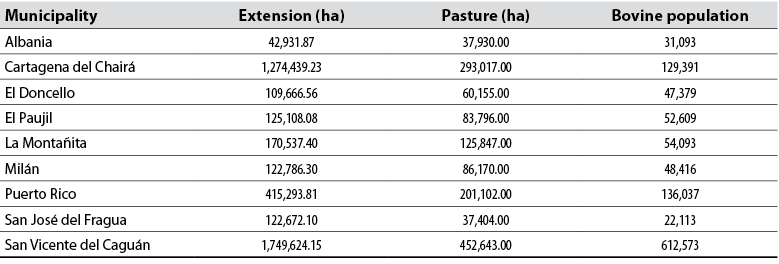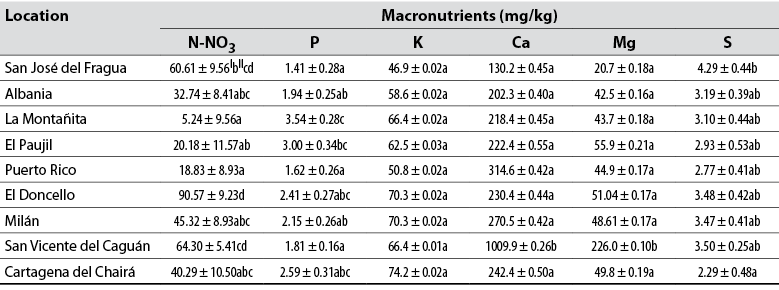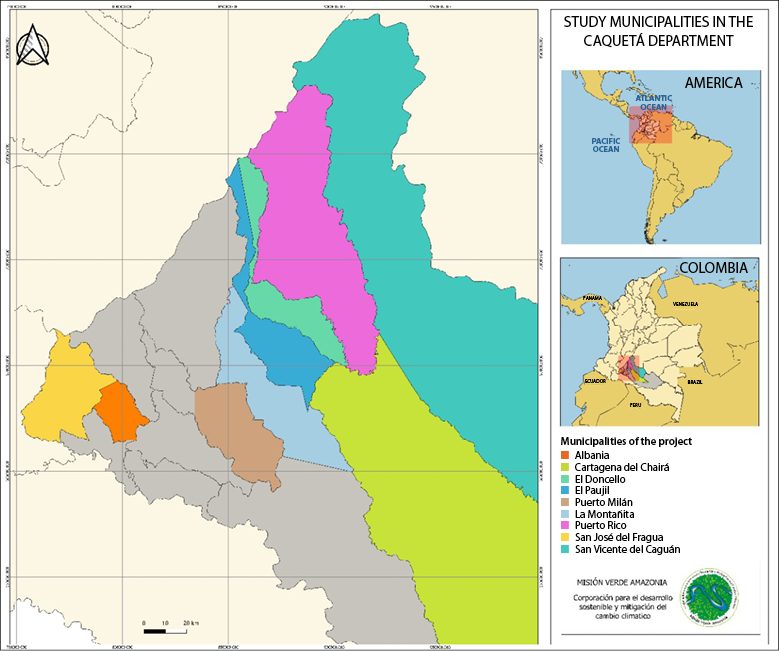Introduction
In the northwest of the Colombian Amazon, the change dynamics of the natural vegetation in pastures is continuously increasing. Currently, the department of Caquetá concentrates the most significant number of early warnings due to deforestation in the country, representing 34.6 % of the national total (Forest and Carbon Monitoring System for Colombia, 2017). Most of the natural forest in this department has been intervened for the establishment of extensive livestock, so up to date, there are 14,251 farms dedicated to this activity (Instituto Colombiano Agropecuario [ICA], 2017).
The soils most affected by extensive livestock farming practices are those located in the hilly landscape of the Amazon region. These soils are poorly drained in the depressions and well-drained in the rest of the territory; they have fine textures with a marked change in the percentage of clay between horizons A and B; they are characterized by having low natural fertility, low oxygen availability and low organic matter content; further, these soils are strong to extremely acidic, and have high aluminum saturation, low base saturation, and poor phosphorus and potassium contents (Rosas et al., 2016).
Nutrient shortages in the soil limit plant production and the development of soil fertility-dependent productive activities (Morgan & Connolly, 2013). Macronutrients are elements that affect the totality of the processes of living beings; therefore, they are indispensable in cattle nutrition (Escudero & Mediavilla, 2003; Silveira & Moura, 2020). Macronutrients perform numerous functions and are classified into two groups according to the amount in which they are found in food: primary, such as nitrogen (N), phosphorus (P), and potassium (K), and secondary, such as calcium (Ca), magnesium (Mg) and sulfur (S) (Ringuelet & Gil, 2005).
Various studies of grazing areas in the Amazon region report loss of primary and secondary nutrients. Luizão (2007) affirms that with pasture age, nutrients are lost in high proportions, and Peña et al. (2013) report diminished Ca and Mg levels in degraded landscapes. Likewise, authors as Becerra-Ordoñez et al. (2014) in their study of macronutrients in soils of plains, hills, and mountains, point out that the values of the Ca, Mg, K and P parameters, regardless of the geoform considered, were similar to those recorded by Peña-Venegas and Cardona (2010) in soils exposed to grazing. On the other hand, Instituto Geográfico Agustín Codazzi IGAC, (2014) carried out a general study that allowed the agrological survey to update and complete the Caquetá soil map and served as an input to establish the quality of the soil in the region.
Given the importance of macronutrients and the constant problems of soil degradation caused by grazing in the northwestern Amazon, the aim of this research was to obtain diagnostic information on the concentration of macronutrients in the lomerío or rolling hills landscape subjected to grazing in nine municipalities of the Caquetá department.
Materials and methods
Study area
The study was carried out in nine municipalities with degraded pastures subjected to grazing in the department of Caquetá (Colombia), located in the northwest of the Amazonia region, between 00°42′17″ and 02°04′13″ N latitude, and 74°18′39″ and 79°19′35″ W longitude of the Greenwich Meridian (IGAC, 2014). The most important type of soil in Caquetá is Ultisol, and bovine animal load ranges from 0.43 AU/ha to 0.72 AU/ha (IGAC, 2014). Furthermore, the department has an average annual temperature of 25.6 °C, rainfall of more than 3,000 mm per year, 1,490 hours of sunlight, relative humidity of 87.1 %, and potential evapotranspiration that reaches 1,232 mm (Instituto de Hidrología, Meteorology and Environmental Studies, 2005; IGAC, 2014). The selected municipalities were Albania, Cartagena del Chairá, El Doncello, El Paujil, La Montañita, Milan, Puerto Rico, San José del Fragua, and San Vicente del Caguán (figure 1), whose characteristics are described in table 1 (Motta-Delgado & Ocaña-Martínez, 2018; Torrijos et al., 2016).
Table 1 Coverage and bovine population characteristics per municipality

Source: Murcia (2014), Murcia et al. (2018), and ICA (2016)
Soil sampling and analysis
In 2016, during the rainy season, an analysis of the concentration of macronutrients in the soil of the lomerío or rolling hills landscape exposed to sporadic fertilization processes with urea, Triple 15 and synthetic amendments, and subject to grazing with plot delimitations using electric or barbed wire fences was carried out, with an extension between 0.5 ha and 8.0 ha. The selected area had pastures degraded by cattle trampling (> 10 years) as the vegetal soil cover according to the criteria established by Dias-Filho (2011): loss of vigor and productivity, presence of diseases and invasion of pests and various types of plants.
Stratified sampling was carried out with nine strata corresponding to each municipality. According to ICA data (2016), the population to be analyzed included plots in 10,299 properties located in nine municipalities. The sample size was calculated from the known population using the following equation:
Where n: sample size; N: population size (10,299); Z: confidence level (p < 0.05); p: margin of success (0.5); q: margin of error (0.5), and d: accuracy (maximum allowed in terms of ratio error) (4.45 %). Thus, a minimum sample size of 463 farms was obtained and, hence, 463 random soil samplings were carried out in the rolling hills landscape subjected to grazing.
Sample collection was carried out, making a hole of approximately 25 × 25 cm per side (area of 625 cm2) and 20 cm of depth. The first 2 cm of the soil were removed and the samples were then extracted following the methodology proposed by the IGAC (nd). These were placed in plastic bags labeled with codes and sent to the laboratory Dr. Calderón Ltda. in the city of Bogotá. The parameters analyzed were concentration (in mg/kg) of nitrate (N-NO3), phosphorus (P), potassium (K), calcium (Ca), magnesium (Mg), and sulfur (S).
The procedure for obtaining P, K, Ca and Mg was performed with a spectrophotometer using the Morgan method modified by the laboratory Dr. Calderón consisting in applying an extracting solution of sodium chloride, citric acid and sodium benzoate in saturated soil paste that must be subjected to shaking for an hour, and finally, filtering. Sodium chloride is used to extract K, Ca and Mg, and citric acid is used to extract P. N-NO3 is measured using a diphenylamine colorimetry kit in sulfuric medium, and S is determined by turbidimetry with barium chloride.
Statistical analysis
The design was a stratified sampling in which the strata were the nine municipalities with unequal repetitions by locality. The number of farms sampled by each municipality was 28 in El Paujil, 34 in Cartagena del Chairá, 41 in San José del Fragua, 41 in La Montañita, 44 in El Doncello, 47 in Milan, 47 in Puerto Rico, 53 in Albania and 128 in San Vicente del Caguán. The variables used were the different macroelements (N-NO3, P, K, Ca, Mg, and S). The data obtained were subjected to a descriptive analysis of variables, and to evaluate these, an analysis of variance (Anova) was performed; the means were compared with Tukey’s test using the InfoStat software (Di Rienzo et al., 2017).
Results and discussion
Considering the results of the analysis of variance in relation to macronutrients (Table 2), the concentration of N-NO3 in the municipalities of San José del Fragua, El Doncello, and San Vicente del Caguán (with an average between 60.61 mg/kg and 90.57 mg/kg) show statistical differences compared to Puerto Rico (18.83 mg/kg) and La Montañita (5.24 mg/kg). On the other hand, the concentration of P in San Vicente del Caguán, Puerto Rico, and San José del Fragua (with an average between 1.4 mg/kg and 1.8 mg/kg), presents significant differences with respect to La Montañita (3.5 mg/kg). The concentration of K showed an average between 46.9 mg/kg and 74.2 mg/kg, and no significant differences were observed between the analyzed localities. San Vicente del Caguán was the only municipality that showed significant differences in relation to Ca (1,000.9 mg/kg) and Mg (226 mg/kg) compared to the other municipalities. Moreover, significant differences were observed between Cartagena del Chairá (average of 2.29 mg/kg) and San José del Fragua (4.29 mg/kg) in relation to S.
The concentration of N-NO3 reported the highest contents in the municipalities of El Doncello, with an average of 90.57 mg/kg, San Vicente del Caguán with 64.30 mg/kg, and San José del Fragua with 60.61 mg/kg; meanwhile, the lowest concentration means corresponded to Puerto Rico with 18.83 mg/kg, and La Montañita with 5.24 mg/kg.
Regarding P contents, San Vicente del Caguán, Puerto Rico, and San José del Fragua recorded the lowest values with means of 1.81 mg/kg, 1.62 mg/kg, and 1.4 mg/kg, respectively. In contrast, La Montañita was the locality with the highest concentration (3.5 mg/kg).
San José del Fragua presented the lowest concentration of K with an average of 46.9 mg/kg, followed by Puerto Rico (50.8 mg/kg) and Albania (58.6 mg/kg). In contrast, Cartagena del Chairá was the municipality with the highest concentration of K with an average of 74.2 mg/kg, followed by Milan and El Doncello, with 70.3 mg/kg each.
Concerning the concentration of Ca, San Vicente del Caguán, with an average of 1,009.9 mg/kg, exhibited the highest values compared to the other localities. The remaining municipalities showed levels of Ca concentration below 314.6 mg/kg.
Table 2 Soil macronutrient means in grazing areas of nine municipalities of Caquetá

I: standard error, II: values in each column followed by the same letter do not differ statistically (Tukey’s test, p < 0.05)
Source: Elaborated by the author
San José del Fragua (20.7 mg/kg), Albania (42.5 mg/kg), and La Montañita (43.7 mg/kg) were the localities with the lowest Mg concentration values regarding the rest of municipalities. On the other hand, the highest concentration of Mg was obtained in San Vicente del Caguán, with an average of 226 mg/kg.
According to studies carried out by Arango and Pérez (2005) in Andisols and Inceptisols, the concentration of N-NO3 in soils cultivated with banana shows a range between 5 mg/kg and 77 mg/kg. Nonetheless, in soils cultivated with flowers, the value ranged between 8 mg/kg and 824 mg/kg. In tropical soils that have agroforestry systems with oil palm crops, the N-NO3 concentration does not exceed 5.5 mg/kg (Santos et al., 2011). On the other hand, Ferreira et al. (2006) identified concentrations of 1.2 mg/kg in a forest with selective wood extraction, and Moreira and Malavolta (2004) found concentrations of N-NO3 of 6.4 mg/kg in a grassland chronosequence. However, in the current research, the N-NO3 values found in degraded pastures range from 5 mg/kg to 90 mg/kg.
According to Keeney and Hatfield (2008), the increase in inorganic fertilizers increases the levels of N in the environment generating imbalances in its natural cycle. It is possible that the N-NO3 levels found in this study, except for the municipality of La Montañita, are due to sporadic fertilizations typically carried out in the region to try to recover the productivity of degraded pastures.
Regarding P concentrations, Fonte et al. (2014) observed that its content decreased with increasing pasture degradation level and stated its possible use as a soil degradation indicator. Furthermore, according to Costa et al. (2006), there is a low level of P in pasture production at concentrations of less than 3.0 mg/kg. The results of the current study coincide with these findings since very low mean P values do not exceed 3.5 mg/kg. The municipalities with the lowest availability of P were Puerto Rico (1.62 mg/kg) and San José del Fragua (1.41 mg/kg).
The data obtained indicates a lower concentration of K in areas subject to grazing (between 46.9 mg/kg and 74.2 mg/kg) compared to the data from a study conducted by Gordillo and Bohórquez (2005) on tropical humid forest soils. The average K values reported by these authors was 208.17 mg/kg. On the other hand, the concentrations obtained in this study are above the critical level (31.12 mg/kg) proposed by Lascano and Spain (1988); however, in San Vicente del Caguán, average values of 46.9 mg/kg are reported, suggesting that the concentrations of K in this locality are close to the levels considered as deficient for the establishment of forage grasses and legumes.
As for the Ca concentration, with an average of 1,009.9 mg/kg, San Vicente del Caguán obtained values close to 1,388 mg/kg reported by Gordillo and Bohórquez (2005). The high concentration of Ca in San Vicente del Caguán may be related to recent burns, according to fire alerts reported in the area by the Forest and Carbon Monitoring System for Colombia (Sistema de Monitoreo de Bosques y Carbono para Colombia (2017). Similarly, Fernandes et al. (1997) suggest that the ashes harbor a large number of bases that have the capacity to neutralize soil pH; this causes, in turn, that the aluminum becomes more soluble and it is released. Subsequently, the soil increases its ability to fix essential elements in plant nutrition, generating higher Ca availability.
Compared to San Vicente del Caguán, the rest of the municipalities showed lower concentrations of Ca; however, these values were close to the ones found in the rolling hills landscape of the Amazon region that were below 600 mg/kg reported by Peña et al. (2013). Thus, these results agree with the Ca concentrations that ranged from 130.2 mg/kg to 314.6 mg/kg found in the current study in the municipalities of El Paujil, Cartagena del Chairá, San José del Fragua, La Montañita, El Doncello, Milan, Puerto Rico, and Albania. Nonetheless, when comparing the values of this macronutrient with those found in the study published by Cabalceta and Molina (2006), the Ca concentration disclosed in the current study is considered deficient for tropical soils.
San Vicente del Caguán showed Mg concentrations of 226 mg/kg, i.e., results higher than the 66 mg/kg obtained by Peña et al. (2013) in the same department. Likewise, differences with the findings of Gordillo and Bohórquez (2005) were identified. These authors reported average values of 1,107 mg/kg of Mg in the soil of humid forests. When comparing the Mg concentrations found in the current study with the critical values suggested by Cabalceta and Molina (2006), the only municipality above these levels is San Vicente del Caguán.
The concentration of S in San José del Fragua, the locality that showed the highest mean value with 4.29 mg/kg, is lower than the result obtained by Lascano and Spain (1988). These authors reported a value of 13 mg/kg in Brachiaria decumbens Stapf pastures (Poaceae). Low concentrations of S in all municipalities, especially in Cartagena del Chairá (average of 2.29 mg/kg), can be associated with possible burns in the area (Sistema de Monitoreo de Bosques y Carbono para Colombia, 2017), given that combustion produces a temporary reduction of S by volatilizing this element (Corrales-Maldonado et al., 2014).
In this context, the data obtained in this study shows a deficiency in the concentration of macronutrients in the areas analyzed compared to the optimal values for tropical soils. This suggests that the production capacity of the pastures has decreased and, consequently, livestock practices are unsustainable (Becerra-Ordoñez et al., 2014; Corporación Colombiana de Investigación Agropecuaria, 2002).
Conclusions
The establishment of the plots destined for livestock farming in Amazonian soils of the lomerío or rolling hills landscape generates a generalized low concentration of essential elements such as P, K, Ca, Mg and S, compared to the optimal macronutrient concentration values for tropical soils. This practice, coupled with soil exposure to high rainfall typical of this type of landscape, leads to soil degradation. Therefore, it is necessary to implement sustainable livestock processes as a strategy for restoring soils in the department of Caquetá.











 text in
text in 





